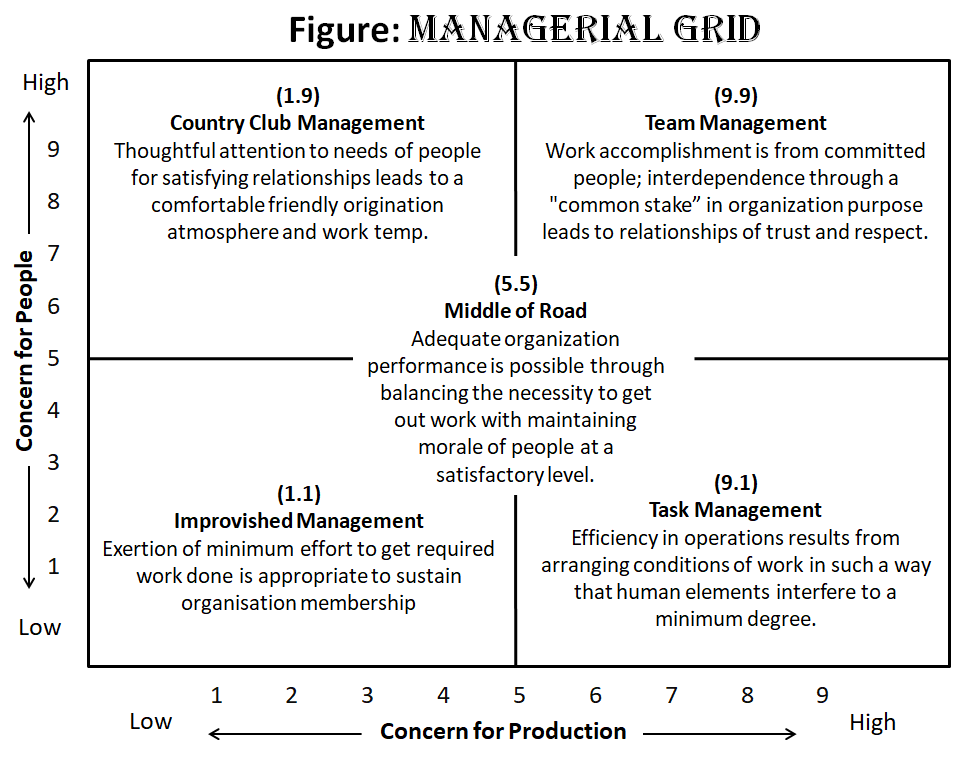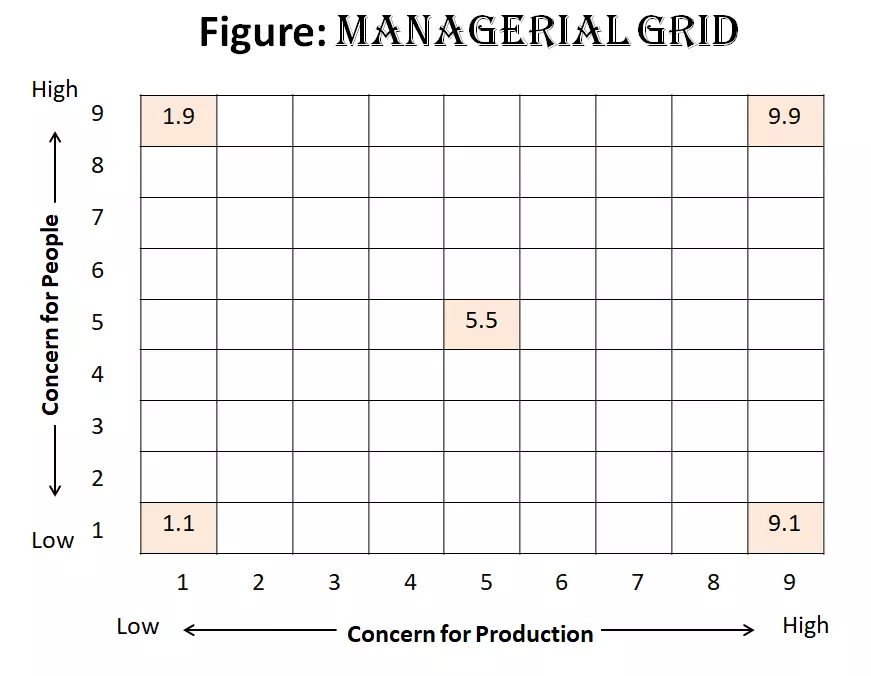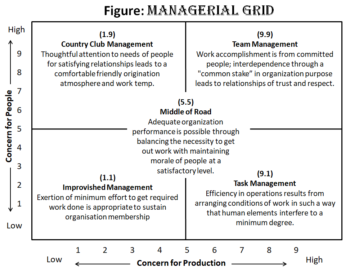What is behavioural theory of leadership?
The behavioural theory of leadership is an extension of the trait theory and is better in certain respects. The traits theory failed to explain the factors that contribute to effective leadership. The behavioural approach is based on the study of a leader’s behaviour. Behavioural theories are practical. These theories believe that leadership grows/develops not by traits but by the acts or experiences of a person. These theories are based on the assumption that leaders are not born but develop gradually through experience and maturity.
The focus is on what leaders do (i.e., their behaviour) rather than what they are. A leader acquires new traits through their experiences (behaviour or actions). The focus point, here, is on what the leader does while leading. Because of the widespread inconsistencies of trait studies of leadership effectiveness, research continued and focused on the styles or behavioural patterns of leaders concerning their interaction with group members. Several research efforts have focused on the two extremes and in-between levels of leadership behaviour.
The behavioural theory of leadership is as follows:
- Ohio State University Studies, and
- University of Michigan Studies
- Managerial grid,
- Likert’s four systems,
Ohio State University Studies
One of the foremost studies that emerged on behavioural theories was conducted by Ohio State University in 1945 by E.A. Fleishman, E.F. Harris, and H.E. Burtt. The study categorized leadership behaviours into two groups, namely initiating structure and consideration, under which various leadership behaviours were grouped.
1. Initiating Structure: Initiating structure refers to the extent to which a leader is likely to structure and define his or her role and those of employees in the pursuit of goal attainment. It includes behaviour that attempts to organize work relationships, work, and goals. A leader with an initiating structure is generally task-oriented, focusing on employee performance and meeting deadlines.
2. Consideration: In the “consideration” category, a leader pays more attention to the employees of the organization rather than the task and shows concern for their well-being, comfort, and satisfaction. In other words, a leader focuses on relationships characterized by mutual trust, respect for employees’ ideas, and regard for their feelings.
These two-factor conceptualizations of the Ohio Studies have gained wide recognition in recent times.
University of Michigan Studies
Similar to the Ohio State University studies, research on leadership studies was also conducted by the University of Michigan’s research centres in 1946 by Rensis Likert and his associates. The study analyzed the relationship between leadership behaviours and organizational performance. The Michigan Studies also identified a two-factor component: “employee-oriented leader” and “production-oriented leader.”
1. Employee-Oriented Leader: The concern of employee-oriented leaders was more on interpersonal relationship with employees. Such leaders paid more attention to the needs of the employees and accepted individual differences among members.
2. Production-Oriented Leader: Production-oriented leaders pay attention to the technical aspects of the job or tasks assigned to employees, rather than focusing on employees. Such leaders gave the least importance to group members and regarded employees as only a means to achieve the ends, that is, the goals of an organization.
It can be observed that the two-factor conceptualization of the Ohio study is similar to the two-way dimension of the Michigan study. While employee-oriented leadership can be compared with the “consideration” component of Ohio studies, production-oriented leadership can be compared with “initiating structure.” While the Ohio studies considered both components to be important for effective leadership, the Michigan studies emphasized the superiority of employee orientation over production orientation.
Managerial Grid
Like the Ohio State and Michigan studies, the Managerial Grid theory of leadership is also based on the styles of “concern for people” and “concern for production.” The Managerial Grid theory of leadership was proposed by Jane Mouton and Robert Blake in 1964.
They emphasised that leadership style consists of facts of both task-oriented and relation-oriented behaviour in varying degrees. They have used two phrases:
1) Concern for Production: Concern for production means the attitude of the superiors towards a variety of factors concerning production, such as products, procedures, processes, quality of staff service, workload, efficiency and quantity of production.
2) Concern for People: Concern for people includes a degree of personal commitment towards goal achievement, maintaining the self-esteem of workers, responsibility and conductibility based on trust rather than on force and satisfying interpersonal relationships.

The above image shows the degree of concern for production and for people and possible interactions (combinations) between them. The horizontal axis represents concern for production and the vertical axis indicates concern for people. Each axis is presented on a nine-point scale of concern, where No. 1 signifies the minimum level of concern, and No. 9 indicates the maximum concern in ascending order.
Managerial Grid Styles
Through the Managerial Grid, five kinds of leadership styles were identified, which include the following:
1. The 1, 1 Managerial Style (Impoverished): 1, 1 scale point indicates that exertion of minimum effort to get required work done is appropriate to sustain organisation relationships. It is characterized by low concern for both people and production (1 by 1).
2. The 1, 9 Managerial Style (Country Club): 1, 9 scale points indicate the thoughtful attention to the needs of people for satisfying relationships which leads to a comfortable, friendly organisation atmosphere and wo tempo. In this the concern for production is low, but for people, it is high (1 by 9).
3. The 9, 1 Managerial Style (Task): 9, 1 scale point indicates efficiency results from arranging work in a way that human elements have little effect. In this, there is a high concern for production and a low concern for people (9 by 1).
4. The 5, 5 Managerial Style (Middle Road): 5, 5 scale points indicate that adequate performance is possible through balancing the work requirements with maintaining the morale of people at a satisfactory level. In this, there is a moderate concern for both production and people (5 by 5).
5. The 9, 9 Managerial Style (Team): 9, 9 scale points indicate that work accomplishment from common people and interdependence through a common stake in an organisation leads to a relationship of trust and respect. In this, there is a high concern for both people and production (9 by 9).
Leadership Grid Theory
This theory is also depicted in a graphical form known as the “Leadership Grid Theory.” The grid is a nine-by-nine matrix that outlines 81 different styles of leadership. The grid has 9 possible positions along each axis, resulting in a total of 81 different positions where the leader’s style may be categorized.
The leader with a rating of (9, 1) is primarily focused on production with minimal concern for people. The leader wants to meet the production schedule and get the task done at all costs. The (1, 9) styles reflect minimum concern for production and maximum concern for people.
The managerial grid approach is attractive, instructive and has a common sense appeal. The grid helps the manager to identify his own leadership styles. It serves as a useful framework for leaders to understand the behaviour and reactions of people at work. However, the managerial grid fails to take cognisance of environmental factors, the nature of subordinates and the nature of tasks. Further, it is impossible to calculate 81 combinations to determine leadership behaviour.

| Style of Leader | Effectiveness | |
| (9,1) Highest concern for production lowest for people. | The impoverished type | Worst leadership style |
| (1,9) The lowest concern for production is the highest for people. | The country-club type | The middle-of-the-road type |
| (1,9) The lowest concern for production is the highest for people. | The autocrat type | People-oriented style |
| (1,9) The lowest concern for production is the highest for people. | The middle of the road type | Maintain present balance style |
| (9,9) Highest concern for both production and people. | The team type | Peak of leadership style |
This theory thus offers a useful framework for conceptualizing and understanding leadership styles. Though behavioural theories contribute to understanding leadership effectiveness, they cannot be considered the ultimate determinant of leadership success. In other words, it cannot be said with utmost clarity that a leader depicting certain leadership traits and behaviours is always successful. At times, situational contexts play a strong role in determining the effectiveness of leaders.
Likert’s Four Systems
Developing on the notion that leadership style consists of two extreme positions – autocratic and democratic. Rensis Likert formulated an influential classification of four system leadership styles for use in the management of the organisation. These systems varied from System 1 to System 4 on a number of criteria, which are explained below:
1) System 1 Management (Exploitative Authoritative)
As an exploitative authoritarian, the leaders:
i) Are highly authoritarian and autocratic,
ii) Have little confidence and trust in subordinates,
iii) Motivate people through fear and punishment,
iv) Engage in downward communication, and
v) Make decisions at the top of the organisation, and exhibit similar characteristics.
2) System 2 Management (Benevolent Authoritative)
As benevolent authoritarians, the leaders:
i) Have a condescending confidence and trust in subordinates,
ii) Motivate people to encourage performance with rewards,
iii) Engage in some upward communication,
iv) Seek some opinions and ideas from subordinates, and
v) Allow some delegation of decision-making at lower levels with close policy control.
3) System 3 Management (Consultative)
It is described as consultative in that leaders:
i) Have substantial, but not complete, trust and confidence in subordinates,
ii) Try to make use of opinions and ideas from subordinates,
iii) Motivate people through rewards with occasional punishment and some participation,
iv) Engage in both downward and upward communication, and
v) Formulate broad policy decisions at the top and specific decisions at lower levels.
4) System 4 Management (Participative)
It is described as participative in that leaders:
i) Have complete trust and confidence in subordinates in all matters,
ii) Make constructive use of ideas and opinions after getting them from subordinates,
iii) Give economic rewards on the basis of group participation and involvement in setting high-performance goals, improving work methods, etc.,
iv) Engage in much communication flow both down and up with peers,
v) Encourage decision-making throughout the organisation, and
vi) Operate with themselves and their subordinates as a cohesive group.
You May Also Like:-
Transactional Analysis in Organisational Behaviour
Techniques of Organisational Development
Need for Organisational Development
Characteristics of Organizational Development
Factors Affecting Organisational Culture
Causes of Conflict in an Organisation
Types of Conflict in an Organisation
Group Decision Making Techniques
Factors affecting group behaviour
Challenges and Opportunities of Organisational Behaviour
Importance of Organisational Behaviour
Scope of Organisational Behaviour
Factors Influencing Perception
